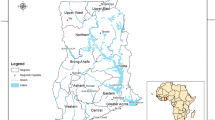Abstract
Despite the rapid development of risk analysis, there is a relative absence of risk criteria for dams in developing countries recently, which restrained the practical application of the research results. This paper proposes guidelines for establishing risk criteria of dams in developing countries in considering the coordination of social, economic and engineering factors, then establishes a method of targeted analysis and demonstrates relevant parameters selected according to the ALARP principle and F-N curves, using China as an example. Different individual life risk criteria are established based on different safety levels for existing dams and newly built dams. Social life risk criteria and economic risk criteria are established on the basis of the different safety levels of all size reservoirs, the seriousness of the consequences of accidents, and the acceptability of social risks. The process of establishing risk criteria of dams and the analysis of the parameters demonstrated in this paper are meaningful to provide a reference and promote the required level of management for developing countries.







Similar content being viewed by others
References
Ale BJ (2005) Tolerable or acceptable: a comparison of risk regulation in the United Kingdom and in the Netherlands. Risk Anal 25(2):231–241
Alipour MH (2015) Risk-informed decision making framework for operating a multi-purpose hydropower reservoir during flooding and high inflow events, case study: Cheakamus River system. Water Resour Manag 29(3):801–815
Australian National Committee on Large Dams (2003) Guidelines on risk assessment. Available at http://www.ancold.org.au/
Aven T (2009) Safety is the antonym of risk for some perspectives of risk. Saf Sci 47(7):925–930
Bottelberghs PH (2000) Risk analysis and safety policy developments in the Netherlands. J Hazard Mater 71(1):59–84
Canadian Dam Association (2009) Dam safety guidelines. Available at http://www.aucklandcity.govt.nz/council/documents/technicalpublications/
Chen ZT, Ren QW (2007) Research on standard of acceptable risk for high arch dam in developing countries. Key Eng Mater 348:601–604
Chitsaz N, Banihabib ME (2015) Comparison of different multi criteria decision-making models in prioritizing flood management alternatives. Water Resour Manag 29(8):2503–2525
Farmer FR (1967) Siting criteria–a new approach. Proceedings of the IAEA symposium on nuclear siting. International Atomic Energy Agency, pp 303–329
Goda K, Hong HP (2006) Optimal seismic design considering risk attitude, societal tolerable risk level, and life quality criterion. J Struct Eng 132(12):2027–2035
Gu SP (2011) F-N curved surface method for establishing the integrated risk criteria of dam failure. Sci China Technol Sci 54(3):597–602
Health and Safety Executive (1992) The tolerability of risk from nuclear power stations. Available at http://www.hse.gov.uk/
Heinrich HW, Petersen D, Roos N (1980) Industrial accident prevention. McGraw-Hill, New York
Henselwood F, Phillips KG (2009) The development of risk criteria for high severity low frequency events. Process Saf Prog 28(1):11–14
Huang L, Ban J, Sun K, Han Y, Yuan Z, Bi J (2013) The influence of public perception on risk acceptance of the chemical industry and the assistance for risk communication. Saf Sci 51:232–240
Jones-Lee M, Aven T (2011) ALARP—what does it really mean? Reliab Eng Syst Saf 96(8):877–882
Jonkman SN, Van Gelder P, Vrijling JK (2003) An overview of quantitative risk measures for loss of life and economic damage. J Hazard Mater 99(1):1–30
Kletz TA (2005) Looking beyond ALARP: overcoming its limitations. Process Saf Environ 83(2):81–84
Laheij GMH, Post JG, Ale BJM (2000) Standard methods for land-use planning to determine the effects on societal risk. J Hazard Mater 71(1):269–282
Li SY, Zhou XB, Wang YJ, Zhou JP, Du XH, Chen ZY (2015) Study of risk acceptance criteria for dams. Sci China Technol Sci 58(7):1263–1271
Lind N (2002) Social and economic criteria of acceptable risk. Reliab Eng Syst Saf 78(1):21–25
Marszal EM (2001) Tolerable risk guidelines. ISA Trans 40(4):391–399
Melchers RE (2001) On the ALARP approach to risk management. Reliab Eng Syst Saf 71(2):201–208
Rogers GO (1998) Siting potentially hazardous facilities: what factors impact perceived and acceptable risk? Landsc Urban Plan 39(4):265–281
State Administration of Work Safety of China (2014) Individual and social acceptable risk criteria for production and storage device with dangerous chemicals (beta). Available at http://www.chinasafety.gov.cn/
Toosi SLR, Samani JMV (2012) Evaluating water transfer projects using analytic network process (ANP). Water Resour Manag 26(7):1999–2014
Vrijling JK, Van Gelder P (1997) Societal risk and the concept of risk aversion. Advances in Safety and Reliability 1:45–52
Vrijling JK, Van Hengel W, Houben RJ (1995) A framework for risk evaluation. J Hazard Mater 43(3):245–261
Vrijling JK, Van Hengel W, Houben RJ (1998) Acceptable risk as a basis for design. Reliab Eng Syst Saf 59(1):141–150
Zhang SR, Tan YS (2014) Risk assessment of earth dam overtopping and its application research. Nat Hazards 74(2):717–736
Zhang M, Yang F, Sun K, Wu JX, Fan ZW, Wang YY (2016) Application of minimum reward risk model in reservoir generation scheduling. Water Resour Manag 30(4):1345–1355
Acknowledgements
The support of the National Natural Science Foundation of China (Grant No. 51379192, 51679222) is gratefully acknowledged.
Author information
Authors and Affiliations
Corresponding author
Ethics declarations
Conflict of Interest
The authors declare that they have no conflict of interest.
Rights and permissions
About this article
Cite this article
Ge, W., Li, Z., Liang, R.Y. et al. Methodology for Establishing Risk Criteria for Dams in Developing Countries, Case Study of China. Water Resour Manage 31, 4063–4074 (2017). https://doi.org/10.1007/s11269-017-1728-0
Received:
Accepted:
Published:
Issue Date:
DOI: https://doi.org/10.1007/s11269-017-1728-0




